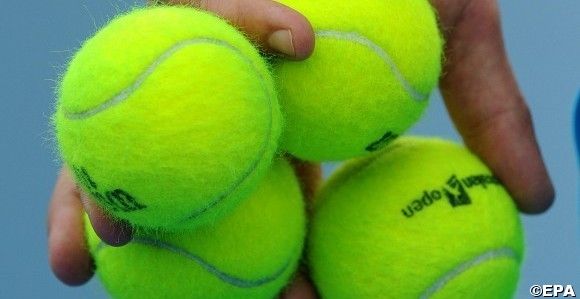Quantitative Analysts Love Gambling In Tennis / But Tennis Powers Don’t Like Gambling
 Quantitative Analysts Love Gambling In Tennis / But Tennis Powers Don't Like Gambling
Quantitative Analysts Love Gambling In Tennis / But Tennis Powers Don't Like Gambling epa04016016 Tennis balls are seen during a practice session ahead of the Australian Open Grand Slam tennis tournament in Melbourne, Australia, 12 January 2014. The tournament will take place in Melbourne from 13 until 26 January 2014. EPA/JOE CASTRO AUSTRALIA AND NEW ZEALAND OUT |
Gambling on tennis has become a huge industry with betting houses propping up all over the place.
Serious gamblers with mathematical brains are also involved in the business. According to Business Insider, Elihu Feustel relies on an algorithm he created using data from 260,000 matches to place about 30 bets a day, but he doesn’t watch many matches. He is even unable to identify top 40 player Marcel Granollers by face. He aims for a 2 percent return on the total amount he bets each year.
Feustel puts in a 60-hour week checking and improving his model and he works with a programmer who searches for data such as serve speed and break point conversions. They then put that information into Feustel’s model, which comes up with what it considers fair betting prices for scheduled games. Those odds are placed on sites such as BetFair, which is based in the UK, and Pinnacle Sports on the Caribbean island of Curacao.
BetFair, which lets people wager against each other online, matched almost $82 million of bets on the 2012 Australian Open final between Novak Djokovic and Rafael Nadal.
Quantitative analysts are rife in the financial industry, pouring over stocks and bonds, but they also find tennis attractive because in singles there are only two players in a match. While little more than serving statistics are available outside of the Grand Slam events, they do have some value.
William Knottenbelt, an associate professor of computing at London’s Imperial College, co-wrote a tennis algorithm that he says would have made an average 3.8 percent return on bets on 2,173 ATP matches in 2011.
According to Warwick Bartlett, the chief executive officer of Isle of Man-based Global Betting & Gaming Consultancy, there may be as many as 20 professional tennis gamblers betting on a similar scale to Feustel.
Not only are there deep pocketed individual gamblers out there, but there are also now funds that raise money from investors to make sports bets such as Australia–based Priomha Capital, a sports-betting investment fund that makes about $100 million worth of bets a year. The fund says it had an annual return of about 28 percent last year.
Topics: 10sballs, Atp, Australian Open, Gambling, Novak Djokovic, Rafael Nadal, Sports, Tennis, Tennis News


10sBalls Top Stories
- Reasons Behind the Increase in Sex Shops
- Reasons Behind the Increase in Sex Shops
- Reasons Behind the Increase in Sex Shops
- Casibom: Yaşayan Casinolar ve Bahisler Lider Platform
- Sea Star Casino: Play Games Without Registering Online
- JETZT DEN SWEET BONANZA SLOT GRATIS DREHEN
- Азартные игры с Мостбет Казино – испытайте удачу
- Çevrimiçi en iyi yuvalar: Hizmetinizde Karavan Bet Casino
- Top No Deposit Free Spins Offer for Canadians – December 2024
- Abe Bet Casino: Ücretsiz dönüşlerle heyecan hissedin
- Ünlü slotlar çevrimiçi kumarhanelerde başarı bet giriş ücretli formatta
- BasariBet Casino Giriş – En Güzel Canlı Casino Oyunlarına Katılın
- Игра на деньги в казино 1вин казино: безопасность
- De parking de credits sans oublier les Diction Casino Archive sauf que Perception
- Играть в хитовые слоты в надежных клубах azino777




